Caroline Wiseman was enjoying her morning dip in the sea off Aldeburgh, Suffolk where two brick towers once served as sailor’s lookouts, when an epiphany struck. “I noticed a ‘for sale’ sign on the south tower and fell into reverie, dreaming about how it would make a wonderful place for artists to work,” she says. When the owner suggested that she bought the tower and his 18th-century house behind it, she jettisoned caution and said yes. “I’d been looking for somewhere to buy: this place is unique.”
Since she set up her first gallery at home in south London, Wiseman has always been an advocate of living with the art that she sells. But the Aldeburgh Beach Lookout is no conventional gallery, “It’s a place where artists can come for a week’s residency. We ask them to respond to the setting in innovative ways, with dance, film, sculpture or poetry,” she says. She also invites artists to stay in the pastel-hued house which she shares with her partner, Francis Carnwath, a former deputy director of the Tate.
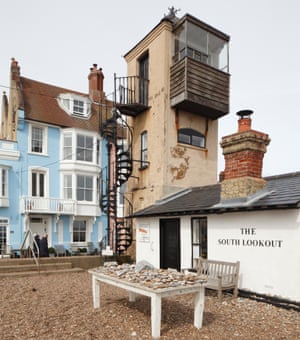
Built in the mid-19th century, the tower served as a lookout for locals to spot ships in trouble. Later, the tower and adjoining boathouse were used for storage by fishermen. When Wiseman first saw the lookout it was “wind-bashed” but beguiling. “For 30 years the author Laurens van der Post used the second-floor room for writing. It was untouched,” says Wiseman, who preserved the original feel of the interior, with its vertiginous metal staircase. She made few changes to the house, apart from knocking through to the nextdoor cottage, bought from the same owner. “We took a section of wall out of the first floor to link the sitting room with my office,” she explains. On the ground floor a door leads from the dining room to the living room in the cottage.
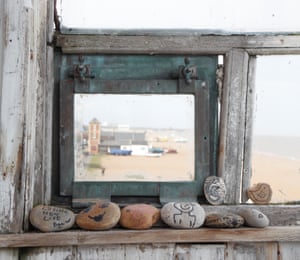
On a midsummer’s day, the interior is uncluttered, welcoming. The walls and floors are painted white and sunshine floods through the new French windows, which open from the cottage on to the shingle beach. Throughout the house you find heirlooms and antiques, including folkish pieces found in upstate New York, where Wiseman used to live, mixed with contemporary art, ceramics and sculpture and 20th-century work by artists such as Terry Frost, some for sale by appointment. “Art isn’t a commodity: it’s about stories, the ideas behind pieces and creating an emotional connection with them,” says Wiseman. “I’ve always believed it’s easier to convey that in a domestic setting.”
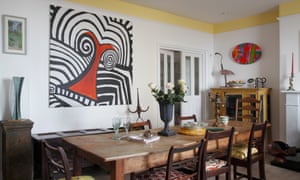
One of her favourite spots is the sheltered terrace, dominated by a face sculpture by Henry Piper made from bicycle parts with car lights for eyes, their glint visible from afar. “This is my spot for reading, thinking, what I call zezzing,” says Wiseman. She was drawn to Aldeburgh by its cultural atmosphere and her exhibitions never shy away from mind-stretching themes. The latest, Einstein and Picasso, draws parallels between the ways in which the artist and scientist viewed space and time: Picasso through Cubism, Einstein relativity.
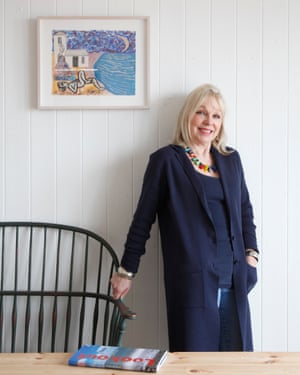
The indefatigable Wiseman has even written a play about power in the art world (key characters include Damien Hirst and Tracey Emin) which made its debut at the Edinburgh Festival. The graphic black-and-white painting in the dining room is a prop from the play. “I’d sold a piece and needed something punchy to fill the gap,” says Wiseman. From here, glass doors lead to the kitchen where Wiseman stripped paint off the walls for a rustic farmhouse effect. A wide cabinet came from Wiseman’s previous home in south London, along with the Aga, which was dismantled and painstakingly reassembled. “We are always entertaining so it’s ideal for slow cooking fish we’ve bought on the beach,” she says. In summer, guests spill out into the boathouse.
Many former residents, including Clara Drummond, who won the BP Portrait Prize, have gone on to find success. Drummond’s striking drawing of a horse hangs in the sitting room, where windows look on to the tower. “We encourage our artists to experiment,” says Wiseman. It is a remit that has lured even established artists. Tai Shan Schierenberg (another BP prize winner), the Turner Prize nominee Alison Wilding and Royal Academicians Eileen Cooper, Sir Peter Blake and sculptor Nigel Hall have found inspiration in the tower where van der Post’s room is furnished evocatively with a Suffolk chair, table and candlestick.
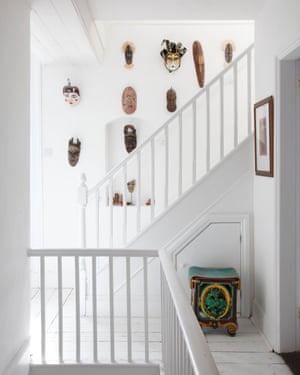
Every residency culminates in a show. In summer, bellinis flow and visitors are asked to write something “about the meaning of existence” on the pebbles piled on a wooden table outside. “We took a gamble when we moved here but it’s paid off,” reflects Wiseman. “It can be bleak in winter but it’s always beautiful… It’s a place that inspires you to be creative, and ambitious.”
Einstein and Picasso: Revolutionaries in Space and Time is on from 7 to 27 July, (aldeburghbeachlookout.com).